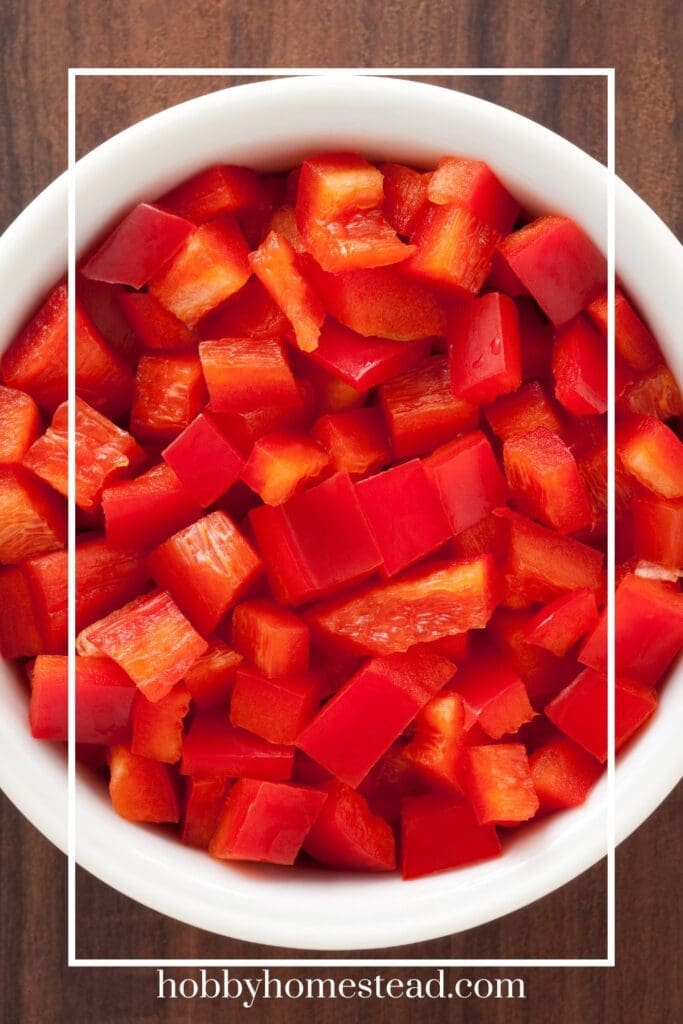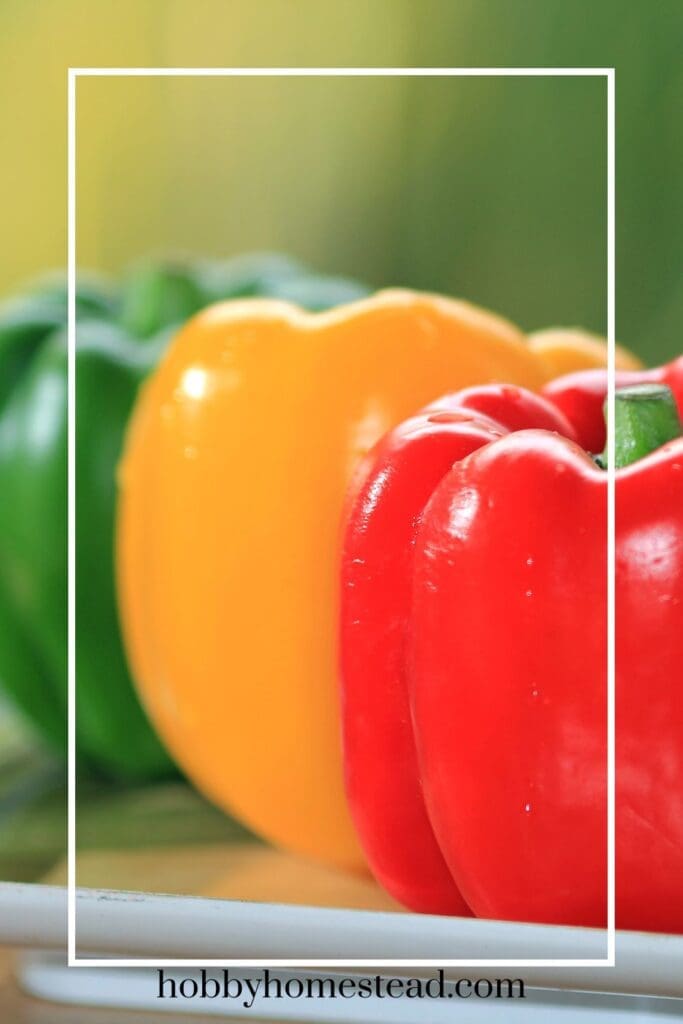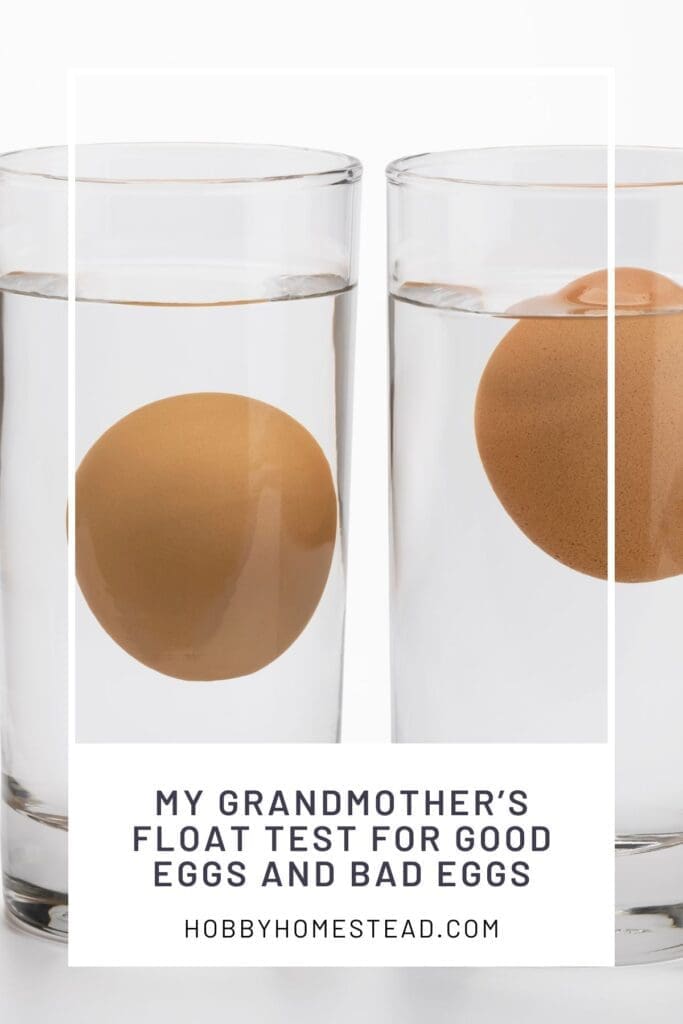Tips to store green bell peppers. If you’ve ever brought home fresh produce home from the grocery store only to find them soft and wrinkled a few days later, you’re not alone. They are part of the fresh produce food group that can go bad quickly without proper storage. Luckily, a few simple tips can help you keep your green peppers (and red bell peppers too!) crisp, colorful, and full of flavor for longer.
Here’s how to store whole bell peppers, cut peppers, and even pepper slices for optimal freshness and longer storage—without wasting a single bite.

🧊 Best Way to Store Whole Bell Peppers in the Fridge
The best way to store whole green bell peppers is in the refrigerator’s crisper drawer. This part of the fridge is designed to keep your fresh produce at the right humidity level.
Best practice:
- Don’t wash your peppers before storing. Too much moisture can cause dark spots, black spots, or mold.
- Place peppers in a produce bag, paper bag, or a plastic bag with a few holes poked in it for airflow.
- Avoid plastic wrap, as it traps moisture.
Whole peppers stored this way can keep their crisp texture and smooth skin for up to 1–2 weeks.
🧊 According to Martha Stewart: Fridge Location Matters
Did you know that where you store your green peppers in the fridge can make a big difference? According to Martha Stewart, placing your whole bell peppers in the crisper drawer is key to maintaining their crisp texture and preventing early spoilage.
The crisper drawer is designed to hold fresh produce at the right humidity level, keeping green peppers, red peppers, and even hot peppers fresher for longer. It’s especially helpful for reducing excess moisture that can cause black spots or soggy skin.
For optimal freshness, keep peppers:
- Unwashed until use
- In a paper bag or plastic bag with holes
- In a single layer to avoid bruising
- Away from moisture-heavy produce
This little change in fridge placement goes a long way in preserving the nutrient content and smooth skin of your peppers — another best practice from Martha worth following!
🫙 How to Store Cut Peppers and Pepper Slices
Once you cut a pepper, it starts to lose its crunchy texture. But with proper storage, cut peppers and small dices can still last 3–4 days.
Here’s the best tips for storing cut green bell peppers:
- Wrap them loosely in a paper towel to absorb excess moisture.
- Place them in an airtight container or airtight glass containers.
- Store in the fridge away from fruits like apples or bananas, which give off ethylene gas and cause peppers to spoil faster.
This method also works well for red peppers, sweet peppers, and even hot peppers.

❄️ Can You Freeze Green Bell Peppers?
Yes! Freezing is a great way to save peppers for later use, especially if you have more than you can use right away.
Best practice for freezing raw bell peppers:
- Wash and dry them thoroughly.
- Remove seeds and slice into strips or small dices.
- Lay them in a single layer on a cookie sheet or baking sheet and freeze until solid.
- Transfer to a zip-top bag, freezer bag, or resealable bag. Remove as much air as possible before sealing.
Frozen peppers are perfect for stir fry, soups, creole cuisine, or homemade hot sauce, but they won’t have the same crispness as fresh peppers. Still, they retain their nutrient content, including that all-important vitamin C.
🧴 Should You Wash Peppers Before Storing?
The USDA’s food safety recommendations say to wait to wash peppers until you’re ready to use them. Washing before storing introduces much moisture, which shortens the shelf life and can lead to brown spots or bad spots.
🌡️ Can Bell Peppers Be Stored at Room Temperature?
If you plan to use fresh peppers within a day or two, it’s okay to keep them at room temperature in a dry place away from sunlight. But for longer storage, the fridge is your best alternative.
🍳 How to Store Cooked Bell Peppers
Whether you’ve roasted a tray of sweet peppers for a side dish or added green bell peppers to a stir fry, knowing how to store cooked peppers properly helps preserve both flavor and nutrient content.
Best tips for storing cooked peppers:
- Let them cool completely before storing.
- Place them in an airtight container or airtight glass container to lock in moisture and flavor.
- Store in the refrigerator for 3 to 5 days.
To avoid sogginess, make sure the container is lined with a paper towel to absorb any excess moisture — especially if the peppers were steamed or sautéed.
If you’ve cooked a large batch, cooked peppers can also be frozen for later use:
- Spread cooled peppers out in a single layer on a baking sheet or cookie sheet and freeze until solid.
- Transfer to a freezer bag or zip-top bag, squeezing out as much air as possible.
- Label and date the bag for easy meal planning.
Great way to use frozen cooked peppers: Add them directly to pasta, rice bowls, omelets, casseroles, or creole cuisine for a quick and tasty meal.

⚠️ Signs of Spoilage to Watch For
When storing peppers, keep an eye out for these signs of spoilage:
- Wrinkled or soft areas
- Brown spots, black spots, or mold
- Slimy or mushy texture
- Sour smell
A slightly wrinkled whole pepper may still be fine for cooking, but toss any peppers with bad spots or a foul odor.
🎥 What About “Make Ahead” Pepper Tips?
Many chefs users love to make bulk pepper slices and prep them in advance. If you try this trend, use an airtight container lined with a paper towel to keep the slices dry. Just be sure to use them within a few days and check for any dark spots before cooking.
🧼 Optional Bonus: Water Bath for Cleaning
Before cooking, wash green bell peppers under cool water. A gentle water bath can help remove dirt from types of produce like bell peppers and cucumbers.
📝 Long-Lasting Peppers
Storing green bell peppers properly goes a long way toward reducing food waste and saving money. Whether you prefer airtight containers, produce bags, or prepping them for the freezer, these methods help preserve that crisp texture and bright flavor you love.
By following these best tips and cooking resources, you’ll enjoy the freshest bell peppers every time—whether you’re slicing them for a salad, tossing them in a stir-fry, or freezing them for later use.
Reference
Martha Stewart. How to Store Bell Peppers the Right Way.
Southern Living. Here’s How To Store Bell Peppers So They Last Longer.


